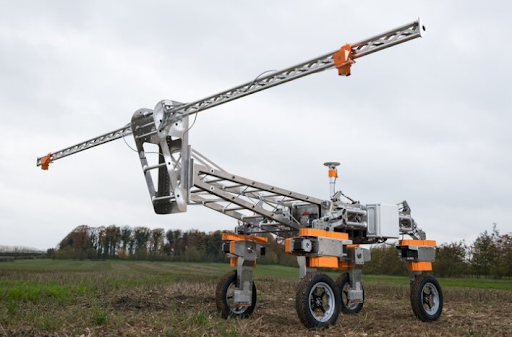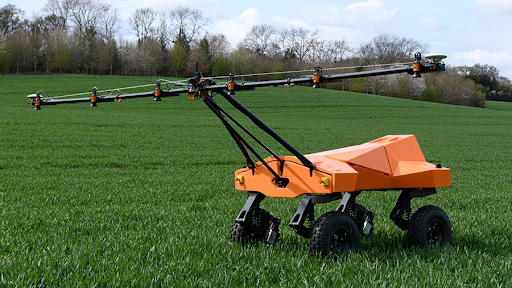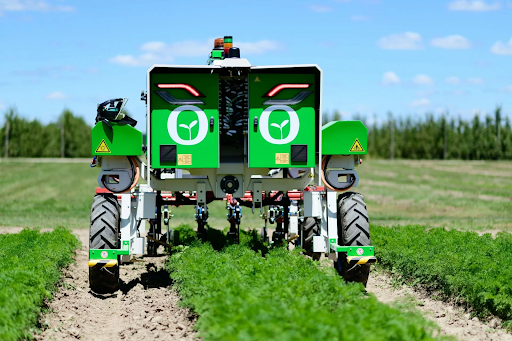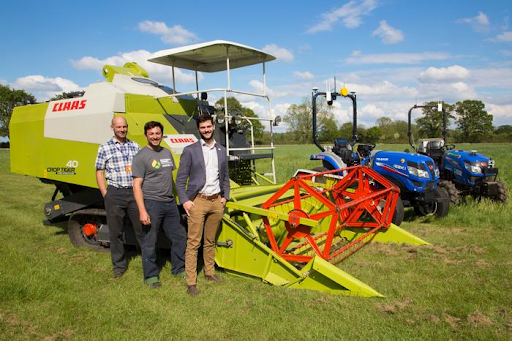Producing food sustainably is one of the greatest challenges facing humanity today. Over-production is common, leading to a huge amount of waste, with more than enough food being produced to feed all of the 8 billion people currently alive on the planet. The World Counts estimates that the 800 million people suffering from hunger and undernourishment could be fed by less than a quarter of the food lost or wasted in the US and Europe.
Implementing sustainable farming techniques, supported by technology, can help tackle this. By deploying IoT sensors across a field and connecting to a private network or local mobile network, farms can monitor their crops, testing water and nutrient levels in the soil. This ensures fertilisers and chemicals are only dispersed when necessary to boost yield; reducing environmental impact (when they’re overapplied, they can also become a pollutant), cost and the need for extra farming staff, important against a backdrop of rising expenditure and ongoing labour shortages. IoT networks can also be used to monitor the performance of farm machinery and irrigation systems while drones can be sent out for routine visual checks of fields.
Monitoring and automating critical tasks like soil irrigation levels can safeguard crop yields and maintain agricultural productivity, even during periods of reduced rainfall. It has been estimated that every 1°C increase in temperature in the UK will create a 27 per cent reduction in water availability for farming and domestic use. For crops such as potatoes and salads, farmers need a guarantee of sometimes two years’ worth of water so they can plan cropping and guarantee supply to the retailers. As climates become more unpredictable, technology can play an important role in providing early warning signals and enabling per-plant precision farming.
Read more below on crop production applications.
Real-time monitoring of environments for smart farm management
According to the UN, about one-quarter of arable land is degraded and needs significant restoration before it can again sustain crops at scale. IoT in crop production helps growers improve the fertility of the land, identify weeds for targeted treatment and protect biodiversity, optimising the environment in which crops grow. From collecting nutrient density information to irrigation levels, temperature and humidity, sensors empower farmers to operate more efficiently and effectively. IoT in agriculture is not necessarily a new concept, but with the addition of advanced connectivity solutions like 5G, the potential grows exponentially, with AI and robotics enabling precision farming at a level not previously seen. Through a process of observing, measuring and responding to various inter- and intra-environment inputs, this technology-enabled approach to farm management allows for more tailored interventions. The smallest changes in on-the-ground conditions such as moisture and temperature can have a big impact on crop outputs. Enabling real-time environmental adjustments helps farmers to prevent and reduce mould, weeds and other threats while providing only the fertilisation and irrigation needed; this reduces costs, creates healthier crops and optimises yields.
Against a backdrop of rising costs of key inputs like fertiliser, real-time monitoring - and the precision management it enables - helps growers to flourish in challenging times, boosting productivity and profitability. If 25% of farms adopted precision farming by 2030, yields would increase by up to 300 million tonnes per year, claims Bell Labs Consulting.
Real-time monitoring of crops for per-plant farming
Crops can also be monitored in real-time, allowing for per-plant farming. With advanced connectivity and the technologies it enables, such as automation, robotics and AI, farmers can monitor each plant’s individual growth, identify biohazards, diseases, signs of plant stress and the best time to harvest. Connectivity solutions such as 5G offer both high bandwidth, allowing for huge amounts of data to be transferred; and low latency, meaning data is transferred in near real-time for time-critical and high-precision interventions such as applying insecticide to a particular plant.
Crucially, growers can use these technologies to predict and identify potential risk factors. From IoT sensors to autonomous drones and machine vision, farmers have access to a level of insight around each plant’s colour and texture down to a pixel level that would never be possible with human workers. This facilitates faster, more tailored corrective action, resulting in better outcomes, higher yields and increased profitability.
Automation for improved efficiencies
The agriculture industry has struggled to recruit the right labour for several years, and the labour shortage, exacerbated by Brexit, has resulted in a 22% rise in wages since 2019. Meanwhile, the average age of a UK farmer is 59 years old; a generation of farmers with a lifetime of knowledge are slowly exiting the workforce against a backdrop of rising costs.
Deploying sensors reduces the need for farm workers to go out into fields to manually collect important data, meaning limited labour can be focused on interpreting data in conjunction with AI, rather than collecting it. Autonomous farming machinery - including drones and autonomous robots - can offer an immediate solution to the problem. The technology performs precise, targeted and individualised interventions based on connected-sensor GPS and imagery analysis, freeing up workers and driving efficiencies.
Increasing the autonomy of machinery through better connectivity could create $50 billion to $60 billion of additional value by 2030, according to McKinsey.
AI for rapid and precise decision-making
With advanced connectivity, the volume of data that can be collected and transferred to growers in near real-time is vast. However, the data is only valuable if it can be analysed and turned into meaningful insights.
This is where AI comes in. The technology can help farmers both identify risks - such as crop disease or damage - and the optimal time to conduct tasks from watering to weeding and even harvesting. Drones using high-quality and AI-powered cameras can tell apart healthy plants from spoilt crops and weeds. AI analysed sensor data can foresee weather patterns, crop yield, soil nutrients and other factors that directly impact operational efficiency.
Equipping growers with this information ensures quicker action with greater accuracy. Ultimately, this will save time, and cost, optimise crop management and increase yields.
Better protect the natural environment
The agricultural sector is intrinsically linked to the natural environment, yet agricultural practices can have negative impacts. When agricultural fields replace natural vegetation, topsoil is exposed and can dry out. The diversity and quantity of microorganisms that help to keep the soil fertile can decrease, and nutrients may wash out, ultimately reducing potential crop yields.
Agricultural runoff is water from farm fields that doesn’t sink into the soil for proper absorption. Instead, it moves over the ground, picking up natural and artificial pollutants along the way. Eventually, those contaminants get deposited into coastal waterways, lakes, rivers and even underground sources of drinking water.
Technologies, powered by advanced connectivity, are here to help. IoT, robotics and AI can enable real-time monitoring, allowing for precision farming. The chances of overwatering are reduced, fertiliser, herbicide and insecticide are used more sparingly and analysis of data can detect and predict trends and patterns in soil erosion.
More sustainable operations
The world will need to produce around 70% more food by 2050 to feed an increased world population of 9.7 billion, according to estimates by the UN. Still, 14% of food harvested worldwide is currently lost between harvesting and retail, with inadequate harvesting time, climate conditions and harvesting methods all contributing to on-farm losses. While crops themselves are extremely vulnerable to greenhouse gas emissions which raise global temperatures, increase pest and weed infestation, and alter precipitation patterns. New approaches are desperately needed: alongside waste, the chemicals used in agriculture are directly responsible for up to 8.5% of all greenhouse gas emissions, and by 2030 the water supply will fall 40% short of global water needs.
Sensors, AI and automated machinery enable precision farming, providing customised rather than uniform interventions and managing everything from watering to weeding and even harvesting more efficiently and sustainably.
Real-time monitoring of weather conditions
Agriculture is one of the most climate-sensitive of all economies. Crop production has always been at the mercy of the weather, too much rain and plants become stressed and die, insufficient rainfall and late frost can negatively impact yields. And now the impact of climate change is undeniable, delivering the UK hotter summers, wetter winters, increased likelihood of flooding, and more extreme and unpredictable weather, increasing the risk of large-scale crop failure.
While in the short- to medium-term, the growth of certain crops, such as maize, may benefit from longer growing seasons and higher temperatures, it is expected that in the longer term, changing patterns of rainfall, increased evaporation and reduced water availability will all threaten crop production. All of which has big implications for farmers and the UK’s food security. Small farms are identified as being most vulnerable to changing climate patterns, and around 50% of agricultural land in the UK belongs to smallholdings.
Connected weather and environmental sensors and AI can help detect, analyse and even predict weather events at a hyper-local level. Farmers can track temperatures, wind speed and direction, cumulative rainfall, ambient humidity, dew point, soil moisture, humectation and humidification of crops field by field, enabling them to respond faster to changing conditions and take preventative actions sooner to minimise the chances of crop damage. As well as identifying optimal windows for both seeding and harvesting.
Predictive maintenance of machinery
With profit margins being squeezed, now more than ever farmers need to increase or at least maintain their outputs. One way to support this is by reducing downtime, especially for critical machinery such as weeding or harvesting robots. As crop production embraces the move to automation, the need to improve performance, minimise downtime and extend the lifetime of machinery will become even more vital.
Computer vision and sensors attached to equipment can feed AI models to allow for predictive maintenance, and the identification of early indicators of wear, tear or malfunction. Advanced connectivity, such as 5G, facilitates the capture and processing of more data about how equipment is operating, in real-time. These insights into an asset’s typical efficiency combined with analysis of vibrations, temperature and oil usage for instance, allow a shift to a predictive maintenance model, which impressively, results in detections up to 90 days in advance. This allows for scheduling and controlling of maintenance and repairs, minimising downtime, extending the lifespan of machinery and avoiding wastage from time-based maintenance approaches.
Improve worker safety and satisfaction
According to Safety Nation, agriculture has the worst rate of worker fatal injury (per 100,000) of all the main industry sectors, with the annual average rate over the last five years around 20 times as high as the all-industry rate. Working with hazardous machinery poses significant risks and in emergency scenarios, being able to call for help, whether that’s from other workers or the blue light services is vital and basic, reliable connectivity is essential.
More advanced connectivity can also support both worker safety and satisfaction. Automation of manual, laborious tasks can free workers up to engage in more fulfilling work and potentially remove them from hazardous scenarios i.e. robotic harvesting.
Security of farming equipment
Farm theft is on the rise: in 2023, NFU Mutual, the UK’s leading rural insurer, released a Rural Crime Report estimating rural crime cost the UK £49.5 million in 2022. Quad and ATV theft are increasingly common against a backdrop of increasing costs and a low supply of farm machinery globally. Rural theft has become more organised and steadily increased since the pandemic, shooting up by 22% in 2022. As a result, the UK cost of agricultural vehicle theft reported to NFU Mutual soared by 29% to £11.7m in 2022.
Connected technology solutions are here to help. Connected CCTV and drones can provide real-time feeds of farmland, with 5G enabling ultra-high-definition quality. Expensive farm machinery can be fitted with geo-fencing, which triggers an alarm if it goes beyond farm boundaries.
Optimising post-harvest management to reduce waste
While enough food is produced to feed the population of the entire world, 14% of all food produced never makes it to the consumer, according to the UN Food and Agriculture Organization. This loss, which occurs throughout the production and food supply chain, from harvest up to the retail level, will need to be curbed if the agriculture sector is to successfully feed growing populations while also reducing emissions.
Key causes of on-farm losses include inadequate harvesting time, climatic conditions, harvesting practices, post-harvest infestation from pests and challenges in marketing produce.
Crop waste is one of the factors that contribute to the accumulation of 1 billion tons of annual agricultural waste. According to research by the US National Institutes of Health, 60% of cereal grains are lost during the storage stage due to spoilage. Connected technologies can help.




